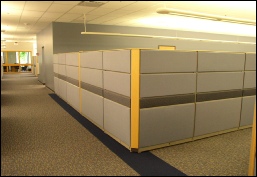Offices
A good office acoustical environment is desirable to optimize comfort and productivity of employees, to minimize annoyance, and to ensure acceptable speech privacy. Design objectives include minimizing reverberation, background noise, the propagation of sounds across the office by reflections, and the transmission of sounds through interior partitions and exterior constructions.
Designs for acoustics involve proper layouts of open-
Acoustical criteria for offices include recommended maximum Reverberation Times,
minimum sound absorption ratings of finishes, maximum background noise levels, minimum
ratings of Outdoor-
We provide design assistance to architects and interior designers to help them choose:
- Office layouts, partition types, and office furnishing components for proper sound insulation and speech privacy
- Room sizes and acoustic room finishes to minimize reverberation and speech reflections
- Electronic background masking systems for enhanced speech privacy
We provide design assistance to mechanical engineers to help them choose:
- Quiet ventilation and other mechanical equipment based on rated sound levels
- Duct silencing where needed to reduce fan noise
- Appropriate selections and layouts of ducts terminal devices to minimize flow-
generated noise


